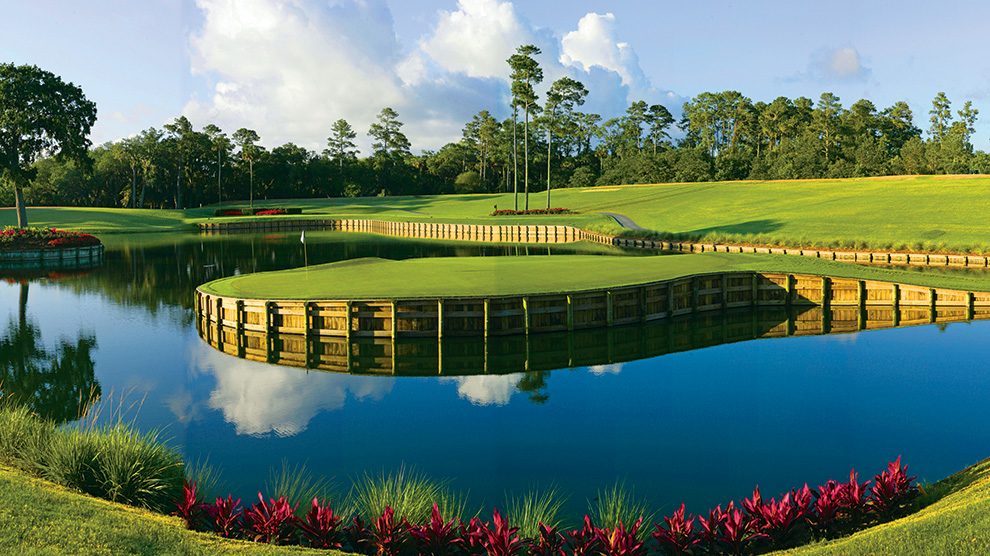After rave reviews came pouring in for stand-in site Eagle Point last week, the PGA Tour returns for its signature event: The Players Championship at TPC Sawgrass. One of the most iconic venues in the world if for no other reason than it’s signature hole is a deceptively simple par 3. Of course I’m talking about the island-green 17th, one of the top 5 best-known par 3s in the world.
Designed by Pete Dye, the course debuted in 1980 as the permanent home for The Players. Previously the tournament had been staged at multiple courses with Jack Nicklaus winning three of the first five editions. The brainchild of PGA Tour Commissioner at the time, Deane Beman, he believed that tough course would bring out the best of players’ games, and the course needed to be as dramatic on TV as it was in-person. Beman set several parameters for architect Dye before construction began on The Players Stadium Course at TPC Sawgrass:
- The course shouldn’t favor a single style of play.
- It must require players to execute a variety of shots.
- Large viewing mounds and central hubs of activity must be built for fans.
Dye produced in spades. Unfortunately, it became so iconic that it unwittingly produced inferior clones that did little to advance modern architecture and, for a time, made Sawgrass into a caricature of itself. Thus, diminishing its audacity and brilliance. While it has been “softened” over the years, it remains a tour-de-force that magnifies then puts a spotlight on the chasm between recreational players and professionals. In short, players of all stripes need to bring their A+ game on every shot or suffer the consequences.
After the tournament ended in 2016 the PGA shut down the course for some major overhaul projects which included:
- Installation of TifEagle Bermudagrass greens to provide superior putting surfaces.
- Transformation of the 12th hole into a risk-reward, drivable par 4.
- A new hazard was created between Nos. 6 and 7.
- The practice facility was upgraded to help players prepare for the Stadium Course’s unique challenges.
- Rough was removed on several holes so wayward tee shots would bounce into pine straw.
- Short grass was added around some greens, like at the par-5 11th to promote creativity.
- Several greens were expanded to add new hole locations.
The most notable is by far, the new 12th hole. Now the hole begins by hitting across a pond with a very oblong bunker down the left side of the fairway and a pond beyond the bunker and to the left of the green. The players will have the option of trying to drive the green (carrying the bunker and not pulling it into the water) or can lay up safely back in the fairway to the right. The green complex is now marked with increased mounding and a few bunkers that aren’t much larger than a manhole cover (perplexing, if you ask me).
Holes To Watch (Other Than 16, 17, and 18)
The finishing holes at TPC Sawgrass get all the glory and will be shown ad nauseum on TV over the weekend, but what holes are interesting and less known?
Hole 4: Par 4, 384 Yards
This drive-and-pitch hole requires accuracy on every shot. First, a player’s drive must stop short of a lateral water hazard in front of the green and avoid a deep meandering fairway bunker on the right. This very undulating two-tiered green gives a plethora of less than friendly pin placements making this protected target tougher than it seems on the scorecard.
Hole 9: Par 5, 583 Yards
This three-shot par 5 again requires concentration from tee to green. Avoiding a wayward drive into the lake way right and a meandering bunker a bit less to the right begin the hole while drives sprayed too far to the left hinder the important second shot. This second shot needs to be directed to the right side of the fairway in order to avoid a wandering fairway bunker and large oak trees that crowd the left side of the fairway and landing area. The green is very thin and severely sloped from the front to the back right. As players progress from tee to green the shots and shot values become narrower and demanding.
Hole 14: Par 4, 481 Yards
One of the toughest holes on the course the narrow two-tiered fairway has a narrow fairway bunker and a lateral water hazard all down the left side. Between the landing area and the green is this same vast bunker turning with the dogleg. The green is very large with severe undulations and long slopes. The green is protected by numerous visible and hidden grass and sand bunkers to the right and the rear of the green.

